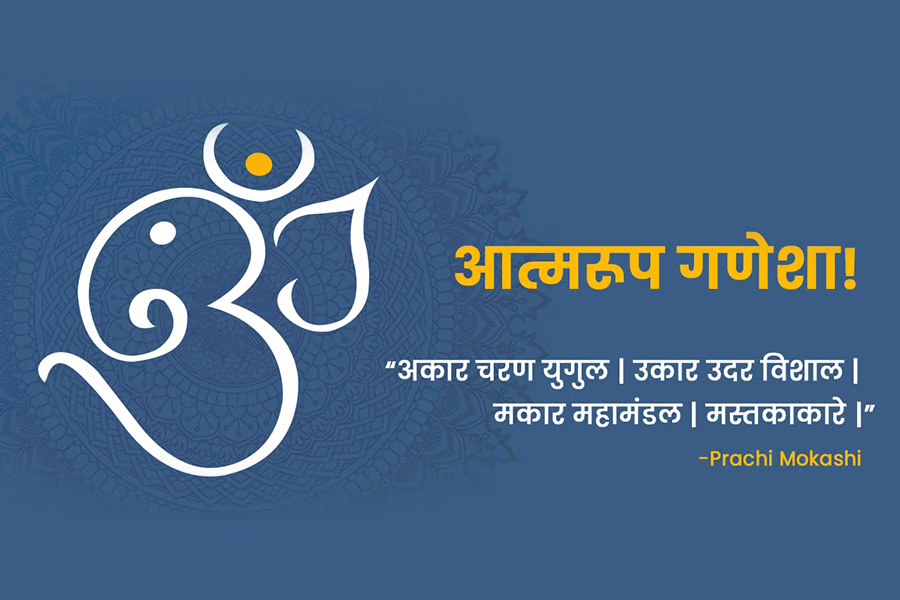

 By Wayam Magazine 15 November 2022
By Wayam Magazine 15 November 2022
By Prachi Mokashi, On 24th August 2020, Children Magazine
Intro-
Ganapati, our beloved deity, is known by the different names and forms. Let’s try to explore more about it..
Friends, Ganesh Chaturthi festival is just round the corner. Lord Ganesha is one “form” of God who is not just worshipped but is loved all-over. Throughout the year, we await His arrival in our homes. So, on this auspicious occasion, let us explore the different names and forms of our beloved deity.
Before starting a new project, it is our custom to venerate Lord Ganesha and pray to Him:
वक्रतुंड महाकाय सूर्यकोटि समप्रभ | निर्विघ्नं कुरु मे देव सर्व कार्येषु सर्वदा ||
The first line of this shloka (श्लोक) describes Lord Ganesha. It says that this deity which has a curved trunk and a huge form embodies the radiance of a crore of suns. The second line is our prayer to Ganesha to bless us so that whatever work we pursue, be it free from any obstacles.
In fact, revered Marathi poet Sant Dnyaneshwar also begins Dnyaneshwari (a Marathi interpretation of Shrimad Bhagvad Gita) by invoking Lord Ganesha.
देवा तूंचि गणेशु | सकलमति प्रकाशु | म्हणे निवृत्तिदासु | अवधारिजो जी |
Addressing himself as the disciple of his elder brother Nivrutti (who was also his Guru), Dnyaneshwar prays to Lord Ganesha to accept his prayers as He is the one who enlightens everyone’s mind. He further goes on to explain the “Omkara” form of Ganesha:
“अकार चरण युगुल | उकार उदर विशाल | मकार महामंडल | मस्तकाकारे |
To understand the meaning of this verse, visualize the “ओम” letter. The “अ”कार represents the two folded legs of Ganesha. The “उ”कार represents Ganesha’s huge belly. The “म”कार is the चंद्रबिंदू situated on the top of the “उ”कार which represents the head of Ganesha. Now, keeping the “म”कार as is, rotate the “उ”कार and the “अ”कार, 90 degrees anti-clockwise to your left and align them with the “म”कार. What you get is an abstract figure, an outline of Ganesha. Could you visualize this? Great!
Centuries later, renowned poet Sant Tukuram worshipped this “Omkara Ganesha” with an entirely different version. For him, Ganesha is a magnificent unison of Brahma, Vishnu and Mahesh. In one of his abhang (अभंग) he says:
“अकार तो ब्रह्मा | उकार तो विष्णू | मकार महेश जाणियेला |
He explains that in the “ओम” letter, the “अ”कार represents Lord Brahma, the God of creation. The “उ”कार represents Lord Vishnu, the God of life and the “म”कार represents Lord Mahesh or Lord Shiva, the God of destruction. Ganesha thus represents the cycle of life – what is created will be eventually destroyed.
Friends, till now what we have seen is the abstract or a spiritual form of Ganesha. But have you ever closely observed Ganesha’s idol-form in its entire splendor - a form with which anyone of us can easily relate?
Let’s simplify this. Ganesha’s idol mostly has four hands – unlike two that humans have – signifying that all the work should be done with double swiftness. There is no room for rest. One of his hands carries a noose (पाश) which means a rope tied into a knot – to bind the evil forces. His other hand carries a sharp weapon (अंकुश) to take a given situation in control. His third hand (वरदहस्त) is always raised to give blessings to his devotees. His fourth hand holds a sweet dumpling (मोदक) which means a giver of happiness. His huge belly (लंब + उदर) represents the ability to digest the good or bad experiences of life. Therefore, He is also called Lambodar (लम्बोदर).
You can see these Ganesha idols in their various manifestations. In some idols, Ganesha is seen sitting on a lotus flower. In some, you see Him ride a peacock. At times, even a lion! But Ganesha riding on a mouse is the most prevalent amongst all His idol representations. The mouse (मूषक) symbolizes victory over darkness. It signifies that the mouse nibbles through the darkness of ignorance to show the light of knowledge. And knowledge is Ganesha, the Lord of wisdom.
In many idols, you can also see a broken tusk of Ganesha. A legend goes that the feather-pen, with which Ganesha was writing the epic Mahabharata as narrated by Maharshi Ved Vyas, broke midway. So, without wasting any time, Ganesha broke his tusk and continued writing uninterrupted. Hence, He is also called Ekadant (एकदंत). His single tusk symbolizes victory over immoralities and the broken tusk represents sacrifices done to achieve virtuous things.
Ganesha is also called Gajanan (गजानन) - one with an elephant’s face. What is the concept behind having an elephant face? Well, this has a very strong scientific reason. An elephant is a very sharp and intelligent animal. It has inbuilt strength. Its trunk is so sensitive that it can delicately pluck a strand of grass or can even uproot a huge tree. By touching its trunk to the ground, it can sense the enemy from a very long distance. Its long ears and eyes are also very sharp. Ganesha is Vighnaharta (विघ्नहर्ता), a remover of obstacles. For this He needs to be intelligent and strong, right?
We saw that our beloved Ganesha is associated with different names and forms. But each one of us certainly has our own form of Ganesha that is etched on our minds. This form cannot be seen but only experienced! This is the divine form of Ganesha or Aatmaroop (आत्मरूप) Ganesha! The real one!
So friends, let us worship this “Aatmaroop Ganesha” so that he bestows on us the blessings of wisdom.
ऑगस्ट २०२० ‘वयम्’